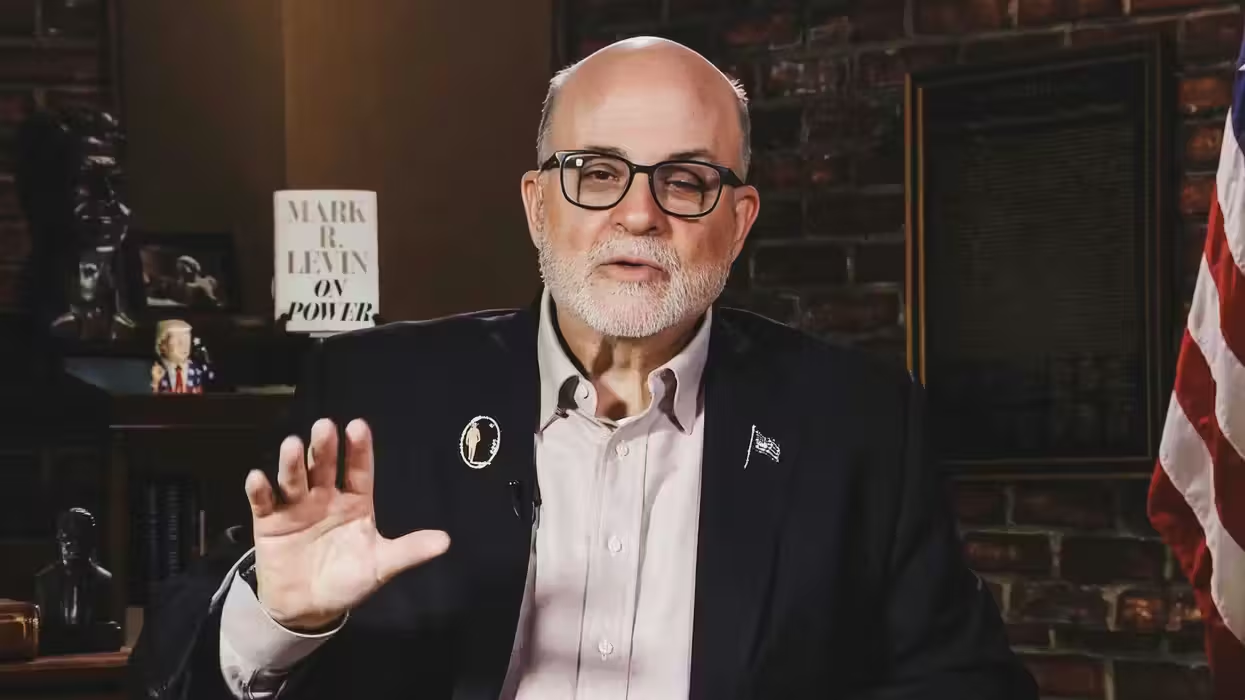
© 2025 Blaze Media LLC. All rights reserved.
Bioweapons Expert: Obama Admin. Has Made a 'Fundamental Mistake' in Its Handling of Ebola
November 12, 2014
Over the past month, 1,745 people originating from countries beset by the Ebola outbreak in West Africa have arrived in United States airports and were "automatically referred" by U.S. Customs and Border Protection for enhanced screening for the deadly virus.
Of those people, eight were transported to medical facilities across the country. None of the eight have tested positive for the virus, but that does not mean they or the other passengers screened are cleared: If infected, a person could incubate the virus for up to 21 days before starting to exhibit symptoms.
By that time, they could be anywhere in the country.
 A member of the medical staff of the Biological Defense Center looks through a window during a press demonstration at the facility in the village of Techonin, Czech Republic, Nov. 5, 2014. The center is capable and equipped for treatment of possible Ebola virus patients. (AP/Petr David Josek)
A member of the medical staff of the Biological Defense Center looks through a window during a press demonstration at the facility in the village of Techonin, Czech Republic, Nov. 5, 2014. The center is capable and equipped for treatment of possible Ebola virus patients. (AP/Petr David Josek)
There is no question for Dr. Serguei Popov, one of the nation's top biochemist and microbiologists, and for other public health professionals that containment is a major part of being able to stop the virus in its tracks. It is a fact, Popov said, that Ebola exists in infected human saliva, so it's not a far stretch to assume it could be transmitted from one person to another in a sneeze or in spit.
Popov, who worked in the bioweapons program of the former Soviet Union and defected to the United States in 1992, said he is baffled by some of the measures the Obama administration has "taken and not taken" to handle the outbreak.
"I don't buy the argument that restricting air travel from Africa would aggravate the epidemiological crisis," said Popov, now a George Mason University professor who researches anthrax and other potential biothreats. "I believe it is disingenuous to the public when they say Ebola is not airborne."
Other Countries Are Taking Protective Measures
Late last month, Canada stopped issuing visas to people from the three hot zones: Guinea, Liberia and Sierra Leone. Australia had made the same move in early October.
Across the African continent, Chad, Kenya, Cape Verde, Equatorial Guinea and Rwanda are some of the other nations that have placed travel restrictions on people entering from afflicted nations.
But those restrictions might not be enough to stop the spread of the virus, according to a study published in Eurosurveillance, a European peer-reviewed scientific journal focusing on communicable disease.
Researchers concluded that "travel bans are only delaying the further international spread of the Ebola outbreak in West Africa for a limited time, at the risk of compromising connectivity to the region, mobilization of resources to the affected area and sustained response operations, all actions of critical value for the immediate local control of EVD and for preventing its further geographical spread."
The Obama administration has made the same argument. Dr. Anthony Fauci, head of the National Institute of Allergy and Infectious Diseases at the National Institutes of Health, said in October that "the strongest argument against it is that when people are coming into the country, you know exactly [and] you can track them.”
Keeping Tabs
But tracking people possibly infected with Ebola is a difficult task, and it's up to each state to track and monitor those who may have come in contact with the virus.
Kristen Nordlund, a spokeswoman for the Centers for Disease Control's National Center for Emerging and Zoonotic Infectious Diseases, said that while CDC specialists work closely with state-level medical personnel, "CDC would leave it up to each individual state to determine the procedure by which to track and deal with Ebola patients."
"We worked with Ohio and Dallas to classify people based on the type [of] exposure," said Norlund, referring to people who may have come into contact with Thomas Eric Duncan, the first patient diagnosed with Ebola in the U.S., and Amber Vinson, one of two nurses infected with Ebola while treating him and who flew to Ohio before her diagnosis.
“We put out our guidance and we put out what kind of monitoring we would suggest is needed. Some states have stricter guidance, while others can be a little less. It starts at the local and state levels and then the CDC is called in,” Norlund said.
Norlund said she could not confirm if the CDC has a national database to track all people who arrive in the U.S. from West African nations and may have been exposed to Ebola.
 Dr. Anthony Fauci, director of the National Institute of Allergy and Infectious Diseases at the National Institutes of Health, has maintained that an Ebola-related travel ban would have “downsides." (AP/J. Scott Applewhite)
Dr. Anthony Fauci, director of the National Institute of Allergy and Infectious Diseases at the National Institutes of Health, has maintained that an Ebola-related travel ban would have “downsides." (AP/J. Scott Applewhite)
On Tuesday, New York doctor Craig Spencer, who contracted Ebola while treating patients in West Africa, was declared free of the virus and released from the hospital, bringing the current number of diagnosed Ebola infections in the U.S. down to zero.
But last week, the New York City Department of Health and Mental Hygiene and the city's Health and Hospitals Corporation said 357 people who had entered the U.S. were being "actively monitored" for a period of 21 days — a threefold increase from the previous week, when only 117 people were being monitored.
Other worldwide possible exposures to Ebola vary, from 3,000 people monitored in Thailand since June to more than 40 being monitored in Mali after a 2-year-old child who traveled from Guinea died of the virus in late October. On Wednesday, Malian authorities confirmed that two new people not connected to the first case had died of Ebola in the country.
Still, thousands more people are being monitored or under quarantine in Liberia, Guinea and Sierra Leon, but many more potential carriers may disappear across borders and travel without reporting to local authorities, the World Health Organization or the CDC.
The current Ebola outbreak, the largest the world has ever seen, has killed an estimated 4,960 people around the globe so far. A hemorrhagic fever disease, the virus spreads through infected bodily fluids, including blood, sweat, urine, feces and vomit, and breaks down the body's cellular structures. There is no vaccine, and treatments consist only of supportive therapies to help the immune system fight it off.
More Questions Than Answers
There are still some lingering questions about precisely how Ebola is transmitted, despite statements from CDC officials and doctors that the virus is not airborne.
In late October, the New York Post reported that a poster released on the CDC's website showed that Ebola could be transmitted through sneeze and saliva "droplets." Shortly after the story ran, the CDC pulled the poster, directing visitors to its Ebola Web page, which did not mention the possibility of Ebola contamination through droplets.
David Dausey, a Yale-trained epidemiologist who is the dean of the School of Health Professions and Public Health at Mercyhurst University in Erie, Pennsylvania, said the public is getting mixed messages. The danger, he said, is that globalization has made it easier for a deadly virus like Ebola to travel, infect and evolve.
 AP/David Goldman
AP/David Goldman
"The challenge is that every time Ebola finds a new human host, there’s an opportunity for the disease to potentially change, mutate, alter, evolve," Dausey told TheBlaze TV's For the Record.
"Just pretend you had a field that’s a mile long and a mile wide, and somewhere in that field there’s a land mine," Dausey said. "If we sent one person walking across that field, the probability that person hits the land mine is actually small ... if you sent 10 people across the field, it probably goes up a little bit. You send 10,000 people across the field, the probability goes up higher. You send a million people across the field, it goes up even higher. And so — the total number of people that are infected with the disease is a concern, and so that’s why we want to try to contain it."
Like Popov, Dausey says stopping the transmission of the virus is paramount. He wrote an opinion piece in the Washington Post asking the administration to stop flights from Ebola stricken nations.
For a layman, it's not easy to decipher what the CDC means when it asserts that Ebola is not an airborne virus, yet can be contained in large droplets of saliva. A sneeze goes airborne at short-range, Popov said.
But the CDC’s guidelines are vague: "There is no evidence that Ebola is spread by coughing or sneezing. Ebola is transmitted through direct contact with the blood or body fluids of a person who is sick with Ebola; the virus is not transmitted through the air (like measles virus). However, large droplets (splashes or sprays) of respiratory or other secretions from a person who is sick with Ebola could be infectious, and therefore certain precautions (called standard, contact, and droplet precautions) are recommended for use in healthcare settings to prevent the transmission of Ebola from patients to healthcare personnel and other patients or family members."
Popov said that throughout history, governments have used containment to stop the spread of a virus.
The U.S. has not placed a travel ban on individuals arriving from Ebola hot zones and in fact weighed bringing infected patients into the country for treatment, as first revealed by the conservative government watchdog Judicial Watch. The State Department subsequently said such measures were not necessary.
 A health worker volunteer talks with residents on how to prevent and identify the Ebola virus in others in Freetown, Sierra Leone, Sept. 20, 2014. (AP/Michael Duff)
A health worker volunteer talks with residents on how to prevent and identify the Ebola virus in others in Freetown, Sierra Leone, Sept. 20, 2014. (AP/Michael Duff)
Popov referred to the 1971 smallpox outbreak that killed three people in a city near the Aral Sea, in what is now Kazakhstan. The city was quarantined immediately by the government and lead to city-wide vaccinations that saved lives. People were not allowed in or out of the city until it was cleared.
Popov said that even though Ebola doesn't travel long distances like other airborne viruses like smallpox or the flu, it could be highly contagious in close quarters and that in urban settings, it could be very easy for a fully infected person to pass the virus from host to host.
"It makes sense to suspect Ebola transmission by droplets of bodily fluids," he said.
Asked about the possibility of Ebola being transmitted by droplet, Norlund, the CDC spokeswoman, referred to the agency's guidelines, which say Ebola is not airborne.
Popov believes that the United States is not taking the possibility of an epidemic seriously.
It is a “fundamental mistake how the administration has chosen to handle this," he said. "[They are] watching the epidemic unfold and not taking the appropriate action to contain it.”
—
Follow Sara A. Carter (@SaraCarterDC) on Twitter
Want to leave a tip?
We answer to you. Help keep our content free of advertisers and big tech censorship by leaving a tip today.
Want to join the conversation?
Already a subscriber?
more stories
Sign up for the Blaze newsletter
By signing up, you agree to our Privacy Policy and Terms of Use, and agree to receive content that may sometimes include advertisements. You may opt out at any time.
Related Content
© 2025 Blaze Media LLC. All rights reserved.
Get the stories that matter most delivered directly to your inbox.
By signing up, you agree to our Privacy Policy and Terms of Use, and agree to receive content that may sometimes include advertisements. You may opt out at any time.






